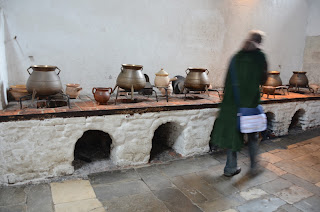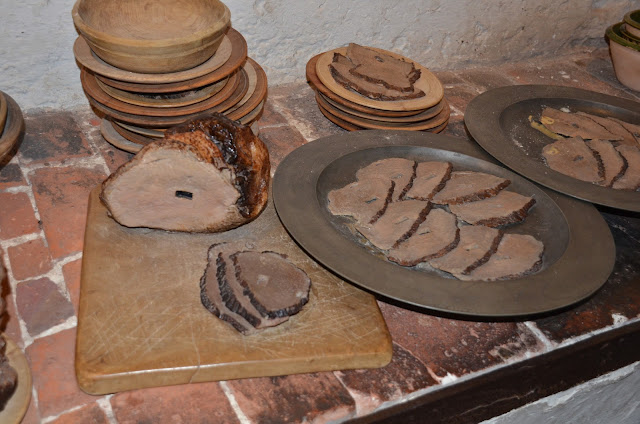According to Hampton Court Palace, "This was a vast operation, larger than any modern hotel and one that had to cope without modern conveniences." (I found the statistics, and many of the details we heard in the audio tour at: http://www.hrp.org.uk/HamptonCourtPalace/stories/thetudorkitchens).
This
was a vast operation, larger than any modern hotel, and one that had to
cope without modern conveniences. - See more at:
http://www.hrp.org.uk/HamptonCourtPalace/stories/thetudorkitchens#sthash.u2YUreub.dpuf
This
was a vast operation, larger than any modern hotel, and one that had to
cope without modern conveniences. - See more at:
http://www.hrp.org.uk/HamptonCourtPalace/stories/thetudorkitchens#sthash.u2YUreub.dpuf
This
was a vast operation, larger than any modern hotel, and one that had to
cope without modern conveniences. - See more at:
http://www.hrp.org.uk/HamptonCourtPalace/stories/thetudorkitchens#sthash.u2YUreub.dpuf
The Kitchen wasn't just one room. There were 55 rooms to complete the tasks needed to feed the court, and Henry, who loved food, almost as much as he loved women. (ok, maybe even more). The first room was the butchery.
They say that "The annual provision of meet for the Tudor court stood at 1,240 oxen, 8,200 sheep, 2,330 deer, 760 calves and 53 wild boar. This was all washed down with 600,000 gallons of beer."
The
annual provision of meat for the Tudor court stood at 1,240 oxen, 8,200
sheep, 2,330 deer, 760 calves, 1,870 pigs and 53 wild boar.
This was all washed down with 600,000 gallons of beer. - See more at: http://www.hrp.org.uk/HamptonCourtPalace/stories/thetudorkitchens#sthash.u2YUreub.dpuf
This was all washed down with 600,000 gallons of beer. - See more at: http://www.hrp.org.uk/HamptonCourtPalace/stories/thetudorkitchens#sthash.u2YUreub.dpuf
The kitchens were located on the south side of the palace, which was the cooler side. This helped preserve the food, just a little bit longer I guess.
The orders and deliveries were carefully monitored by clerks, who lived, and had offices across the courtyard.
I loved this "Recipe Hook" on the wall in one of the rooms.
Look at these old graters hanging below a shelf!
Joseph just helping out, ladling stuff...with a BIG ladle.
There was a smaller, interior courtyard where the entrance to some of the kitchen rooms resided. I imagine part of this was to increase airflow, but that is just a guess.
This space was called the Fish Court.
The Fish storage room door was unique, in that it had ventilation openings at the top of it.
It was a very small room, very narrow. I wondered if it had something to do with keeping it cooler inside.
This is where the meat pies were assembled.
This sideboard was just outside the room, in a nook in the hall. I am sure that when they finished a pie it would go on the board, and then someone would come get them and take them to the baking room.
"The spicery was filled with exotic spices imported from the Orient and Europe, as well as English mustard and herbs grown in the palace's herb garden. The Office of Spicery was responsible for the huge quantities of fruit produced in the palace gardens, including apples and pears from two orchards. "
 | |||||||||||
| The "Stove!" |
A bread oven.
 |
| Pretty Pots |

The fireplaces were MASSIVE in this place! I can't imagine working in one of these rooms in the middle of summer. No wonder Cinderella got the nickname she did!
This is one way to let people know the room is closed for cleaning.... no idea what is happening here. But too fun to not snap a picture. (Maybe Harry Potter followed us to Hampton Court!)
Joseph in front of another ginormous fireplace with a Spit-rack for roasting! And yes, the fire was real, and the heat was intense.
Can you imagine the amount of wood they would need to keep those fireplaces and ovens ablaze?
This was a washbasin of some sort. Pretty cool.
I thought this was interesting. You can see where the skewer from the spit was centered in the meat, while it cooked over the fire. "Roasted meat graced almost every meal at the Royal Court as it was an expression of wealth for several reasons. Fresh meat all year was only available to the rich (most people would have eaten preserved meat); ordinary folk would have boiled meat whereas the rich could afford to roast it before a fire, a technique that wastes most of the fuel, plus you had to pay the ‘spit boy’ who sat all day turning the spit. It was truly a dish fit for a King!"
This was the inventory office for the dinner ware. What a job to keep track of all the pieces, and keep them polished and in tip top shape!
For some reason, I loved the shape of the spoons.
Some storage for part of that 600,000 gallons of ale!
"The palace had three cellars. The wine cellar, with attached drinking house for wine tasting, held 300 casks of wine for courtiers (wine and ale for the sovereign was kept in the privy cellar). Ale was stored in the great cellar –
an incredible 600,000 gallons of ale would have been drunk every year at court. This had two locks on the door and the keys were held by two different officials for extra security."
Here is a Tudor Recipe for you to try, if you want. :) It looks to be similar to a Pease Porridge. It is from The Taste of Fire, a cookbook put together by food archeologists and curators at the Palace. You can order the book here: Purchase "The Taste of Fire".
PERRE:
Take grene pesyn, and boile hem in a potte; And whan they ben y-broke, drawe the brot a good quantite throg a strynour into a potte, And sitte hit on the fire; and take oynons and parcelly, and hewe hem small togidre, And caste hem thereto; And take pouder of Canell and peper, and caste thereto, and lete boile; And take bynegur and pouder of ginger, and caste thereto; And then take Saffron and salte, a litull quantite, and caste thereto; And take faire peces of paynmain, or elles of suc tendur brede, and kutte hit yn fere mosselles, and caste there-to; And then serue hit so for.
Or in other words...
Take some peas and boil them in water until well cooked and very soft. Pass them through a sieve to create a puree and remove the husks then return the puree to the heat. Add some finely chopped onions and parsley, ground cinnamon and pepper and continue to cook. Next add ground ginger, vinegar, saffron and salt along with a small quantity of fine white bread. Continue cooking until the bread is completely incorporated into the puree, and then serve.












































No comments:
Post a Comment